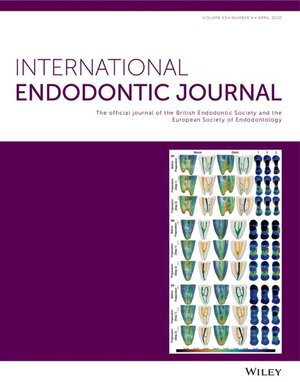The aim of this study is to investigate the expression of inflammatory biomarkers (TNF-α, IL-10, IL-1β) and the pulpitis-associated miRNA (miR-30a-5p and miR-128-3p) in pulp tissue samples from unrestored teeth with a vital normal pulp (NP), teeth with symptomatic irreversible pulpitis (IP) and in unrestored teeth with periodontal disease, unresponsive to periodontal therapy, and a vital pulp (EP).
Thirty patients were included in this observational study (10 teeth with NP, 10 teeth with IP, 10 teeth with EP). Dental pulp tissues samples were collected from patients during root canal treatment (RCT). RNA was extracted and qRT-PCR of target genes (tumour necrosis factor [TNF]-α, interleukin [IL]-1β, IL-10) and miRNAs (has-miR-30a-5p, has-miR-128-3p) performed to assess the expression profile. Fold-change in expression was calculated using the formula 2−(ΔCt(Exp)−ΔCt(Ctrl)). One-way anova with post-hoc Tukey's was used to determine significant differences between groups. The significance level was set at 5% (p < .05). All teeth were also followed up clinically for 1 year and evaluated for a range of endodontic and periodontal-related outcomes.
All investigated genes significantly increased in expression and miRNAs significantly decreased in expression in the IP and EP groups compared with the NP group (p < .05). With regards to TNF-α and IL-1β there were no significant differences in expression between the IP and EP groups (p > .05), whereas IL-10 expression levels were significantly reduced in the EP compared with the IP group (p < .05). Both miR-30a-5p and miR-128-3p showed significantly reduced expression in both IP and EP lesions, compared with NP (p < .05); however, no significant differences in miRNA expression were observed between IP and EP groups (p > .05). One year after root canal treatment and periodontal maintenance, tooth mobility and probing depth were significantly reduced in the EP group (p < .05).
Pulp tissues from teeth with IP and EP presented similar levels of altered inflammatory markers compared with NP. TNF-α, IL-10, IL-1β cytokines and miRNAs (miR-30a-5p and miR-128-3p) are potential objective biomarkers to indicate pulpal inflammatory status, aiding diagnosis and directing clinical decision-making. RCT may be beneficial to improve stage III periodontitis unresponsive to non-surgical periodontal treatment, but further research is required.



